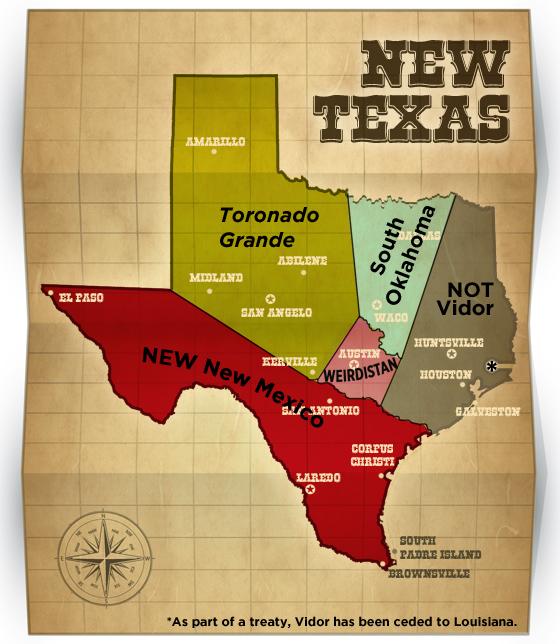 |
| Senator John Nance "Cactus Jack" Garner (D-TX) suggested splitting Texas into five states. |
It’s unusual to carve a new state out of an existing one, or even to redraw state boundaries. The United States’ Constitution makes it very difficult to do. Not only would the residents of the existing and potential new states have to agree, Congress has to agree, too. In 1820, the new state of Maine was carved out of Massachusetts, and the new state of West Virginia was (sort of) carved out of Virginia. Besides that, there have been occasions where state boundaries were nudged a little bit, but for the past century, things have been pretty calm on the new-borders front.
That’s not to say there are no efforts to break new states out of the old ones. Most of these efforts don’t go anywhere—a handful of counties in rural Colorado tried to form the state of North Colorado in 2013, complaining that they didn’t get the attention they deserved from the government in Denver. The residents of southeastern Arizona made a similar complaint in 2011, calling for the creation of the state of Baja Arizona. A 1972 proposal to carve the state of Forgottonia out of western Illinois was clearly more of a protest than a proposal. In fact, most such proposals are intended to express dissatisfaction with the status quo than they are to create legitimate, functioning states. Some say there is one exception to this rule. Others say that exception does not exist. The case in question: Texas.
Texans enjoy thinking of themselves as a little different from the rest of the country. It’s one of the three states that joined the United States not as a founding colony or as a territory, but as an actual, established republic. When the Republic of Texas became an actual state in 1845, it claimed that the aforementioned law that Congress must approve any new states carved out of it didn’t apply, and that Texas, if it wanted to, could divide itself into as many as five different states. This was controversial at the time; Congress never actually agreed with Texas’s claim. Congress still doesn’t, and whether Texas has this right or not is still disputed. It’s also still academic, since the government of Texas has never actually tried to split the state up.
The first proposal to do this came in 1860, right before the Civil War, when it was suggested that part of eastern Texas be cut off and made into the state of Jacinto. Later, in 1869, it was proposed that the southern third of the state be cut off and established as the state of Lincoln, but Congress voted it down. (This can’t be considered a test of Texas’s claim that it can subdivide, since Texas had not yet been readmitted to the Union following its exit before the Civil War. Texas was readmitted as a state in 1870.) In the early 1900s, there was an active movement to merge the Texas Panhandle with the Oklahoma Territory to form the state of Texlahoma, and in 1915, there was another movement to break the Panhandle off and form the new state of Jefferson. (Jefferson is the most popular state name that never got used. Originally a state of Jefferson was proposed to include Colorado and some of the surrounding territory; in the 1940s, a state of Jefferson to be carved out of northern California and southwest Oregon was also proposed.)
Perhaps the most ambitious plan to divide Texas was put forth by Senator John Nance “Cactus Jack” Garner (D-TX), who penned an editorial in the New York Times in 1921 that not only can Texas unquestionably subdivide into five new states, it should. In Garner’s editorial, he expressed concern for the growing population of the state and its disproportionately small representation in the Senate. Among other concerns, he asserted that it’s not fair to the residents of very large states that they should get just two senators to represent them, while very small states get the same two. This is an argument that’s been going on in America since the Constitution was written.
But old Cactus Jack had an ace up his sleeve. He was a proud Texan, and couldn’t see how any Texan would want to part with their Texan identity any more than he would. So, Garner reasoned, the name of each new state should retain the name of the mother state. His proposal was to form the states of North Texas, South Texas, East Texas, West Texas and, in the middle, Old Texas. These five new states could hold on to their Texas heritage while breaking into five more manageable states. It would also just happen that there would be a bloc of ten senators hailing from one Texas or another, giving Texas a much greater voice in the Senate than it would otherwise have. Senator Garner couldn’t have minded that!
Of course, it never came to pass. In the 90-plus years following Garner’s proposal, numerous other divisions of Texas have been suggested, and nothing has come of them, either. In 2009, political prognosticator Nate Silver wrote about a hypothetical five-way division of Texas, and how that might have played out in the 2008 election. His conclusion: the new states wouldn’t have been as solidly Republican as they were in that election (and in nearly every election since 1980). Considering the variety of the cultural landscape of Texas, maybe the ten senators from those hypothetical new states wouldn’t be such a predictable bloc, after all!
 |
| The Houston Press made some suggestions for division in 2014. |


Comments